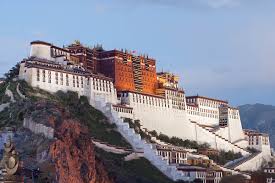 The Potala Palace in Tibet, is the former home of the present and 14th Dalai Lama. Built nearly 400 years ago, it has been considered the spiritual capital of the country for centuries. Used as a winter residence for the leaders of Tibet since the 17th century, this architectural wonder, is the 12th stop in our series Journeys to Discovery.
The Potala Palace in Tibet, is the former home of the present and 14th Dalai Lama. Built nearly 400 years ago, it has been considered the spiritual capital of the country for centuries. Used as a winter residence for the leaders of Tibet since the 17th century, this architectural wonder, is the 12th stop in our series Journeys to Discovery.
This practically surreal complex of buildings, was listed by USA Today, an American national newspaper and the American television show Good Morning America, as one of the New Seven Wonders of the World back in 2006.
The Potala Palace covers over 13 hectares or 32 acres in its entirety. The interior space comprises an amazing 130,000 square meters which is more than 426,509 square feet.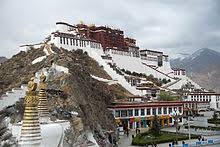
It also has the distinction of being the highest palace in the world. The name originates from the mythological Mt. Potala, which is said to be located in southern India.
No building in Lhasa today, is allowed to be higher than the Potala Palace. This rule of construction is followed by developers, as a sign of respect to the holy site.

Ngawang Lobsang Gyatso was the 5th Dalai Lama, & 1st Dalai Lama to wield effective temporal & spiritual power over all Tibet.
The 5th Dalai Lama started construction of the Potala Palace in 1645, after one of his spiritual advisers, saw the site as an ideal location, for a new seat of government. The new construction would be situated between the Drepung and Sera monasteries and the old city of Lhasa.
The construction of the White Palace was completed in 1648. The Red Palace would be built between the years 1690 and 1694. The latter construction took the work of over 7,000 manual laborers and 1,500 artisans and craftsmen.
The Potala Palace is a virtual treasure house, of splendid artwork and artifacts, which can be traced back through many centuries. It has earned the nickname heaven of arts. The most outstanding art is the 698 murals on the walls, that tell the history of Tibet.
In 1922, the 13th Dalai Lama made a number of renovations to the complex and added two floors to the Red Palace. Recent renovations occurred from 1989 to 1994 and again in 2002.

Songtsen Gampo was the 33rd Tibetan king and founder of the Tibetan Empire
Legend has it that the new building took place over the former fortress and royal residence, known as the Red or White Palace. This fabled structure was supposedly built in 637 by Songsten Gampo. It was built as a gift, for his future wife.
The original palace would be largely destroyed in the 9th century. It would remain mostly deserted, for the next 800 years.
Gampo is known to be the founder of the Tibetan Empire and is traditionally credited, with the introduction of Buddhism to the area, as well as the Tibetan alphabet.
According to Tibetan convention, the three main hills of Lhasa represent the Three Protectors of Tibet.
These are Chokpori (Iron Hill), just to the south of the Potala Palace. It is the soul mate of Vajrapani, who was the guide and protector of the Buddha.
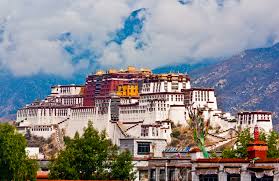 Pongwari is the second hill, associated with Manjusri and the third is Marpori, the hill where the Potala itself sits on. It represents Avalokitesvara.
Pongwari is the second hill, associated with Manjusri and the third is Marpori, the hill where the Potala itself sits on. It represents Avalokitesvara.
The Potala Palace measures a total of 400 meters (1,312 feet) east to west and 350 meters (1148 feet) north to south. Sloping stone walls average about 3 meters (9.84 feet) thick and 5 meters (16.4 feet) at the base of the structure.
An ingenious addition to the stone foundations, as a way to help with earthquakes, was to pour copper into them.
The Potala Palace rises 13 stories high a total of 384 feet or 117 meters on top of Marpori (the Red Hill). The latter rises more than 1,000 feet or 300 meters in total, above the valley floor.

14th and present Dalai Lama, in exile as of 1959
The complex of buildings are comprised of over 1,000 rooms, 10,000 spiritual shrines and some 200,000 religious statutes.
Following the departure to India of the Dalai Lama, during the Tibetan uprising of 1959, the Potala Palace would itself, be turned into an official museum.
The Potala would later be made a UNESCO World Heritage Site. Cataloged as the Historic Ensemble of the Potala Palace, Lhasa in 1994,extensions to listing would be made in 2000 to include the Jokhang Temple (monastery) and in 2001, to encompass the Norbulingka area (Summer Palace).
The Jokhang Monastery meaning House of Buddha, was originally built in 647 and the Summer Palace was built in 1755.

Jokhang Monastery
The best time to view the Potala is first thing in the morning. When one arrives for the first time at the Potala Palace, as the mist separates from the mountain, an almost heavenly vision greets the visitor.
This seemingly mythical place, captures the imagination of most tourists and allows them to envisage a different time, when Tibet was viewed by outsiders, as a mysterious place, the home to Shangri La.
Built at an altitude of 12,100 feet or 3,700 meters, the Potala Palace with its vast inward sloping walls broken only in the upper parts by straight rows of many windows and its flat roofs at various levels, is much like a fortress in appearance.
At the south base of the rock, is a rather large space enclosed by a wall and a gate. There are porticos on the inner side. There exists a series of staircases, broken by intervals of easy ascent, which eventually leads to the summit of the rock. The whole width of this, is occupied by the palace.
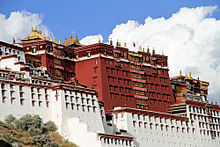
The Red Palace
The central part of this group of buildings, known as the Red Palace, rises in a huge polygonal shape to a great height and ends in gilt canopies.
Contained within are the principal chapels, halls, libraries and shrines of the past Dalai Lamas. They are characterized by decorative paintings, intricate carvings, jeweled work and other ornamentation.
The Red Palace is devoted to Buddhist prayer and religious study. There are a numerous passages, that follow a complicated layout. These lead to a complex of smaller galleries, used for various spiritual purposes.
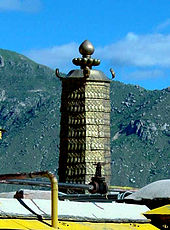
A Dhvaja (victory banner) on the roof of the Potala Palace.
It also contains the sacred gold stupas (the tombs of eight former Dalai Lamas) an assembly hall for the monks, as well as numerous chapels and shrines.
The main central hall of the Red Palace is the Great West Hall. It consists of four great chapels that are dedicated to the 5th Dalai Lama. The hall is famous for its fine murals depicting the life of the Dalai Lama. The most famous scene located on the east wall outside the entrance, pictures his visit to the Shunzhi Emperor of China.
The Great West Hall’s numerous columns and pillars, are all wrapped in special cloth imported from Bhutan.
The tomb of the 13th Dalai Lama is located west of the Great West Hall. Built in 1933, the giant stupa is 46 feet high (14 meters) high. Elaborate murals, depicting the events of the life of the Lama, during the early 20th century, can be found here in abundance.
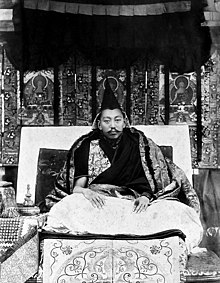
Thubten: 13th Dalai Lama
Reign July 1879 to December 1933.
On the north side of the Great West Hall is the Saint’s Chapel. This chapel like the cave below it, date from the 7th century. On the floor below, a low dark passage leads into the Dharma Cave, where Songsten Gampo is believed to have studied Buddhism. It is decorated in historical images from that time period as well.
The North Chapel is centered on a crowned Buddha on the left and the 5th Dalai Lama on the right. On the far left of the chapel, is the gold stupa tomb of the 11th Dalai Lama.
The South Chapel is centered on Padmasambhava, the 8th century Indian magician and saint.
The East Chapel is dedicated to Tsong Koopa, the founder of Goplag tradition.
The West Chapel contains fine golden stupas. The central stupa is 49 feet high and contains the remains of the 5th Dalai Lama. Built of sandalwood, it is coated with 3,721 kilograms of gold, the equivalent of some 4.102 U.S. tons. It is then studded with 18,680 pearls and semi-precious jewels.
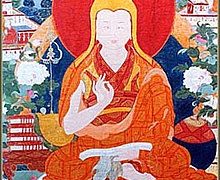
Trinley 12th Dalai Lama, reign was from 1860–1875
On the left is the funeral stupa for the 12th Dalai Lama and on the right the 10th Dalai Lama.
Tourists can also view three main galleries. The First Gallery displays magnificent murals, that show how the Potala Palace was built in great detail. The Third Gallery also contains fine murals and enormous collections of bronze statues.
The Second Gallery along with giving access to the central pavilion, is where visitors can purchase various refreshments and souvenirs.
The White Palace ( in Tibetan Potrang Karpo) is the part of the Potala, that comprised the residence of the Dalai Lama. The original portion, was built during the life of the 5th Dalai Lama. He moved himself and his government there in 1649.
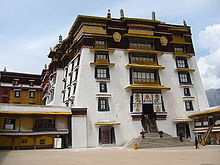
The White Palace
It would be extended to its present proportions by the 13th Dalai Lama, in the early part of the 20th century.
The White Palace contains in addition to living quarters, a seminary, a printing house and various other offices.
There is a central courtyard (Deyangshar) painted yellow, that separates the living quarters of the Lama and his monks, from the Red Palace.
The yellow building at the side of the White Palace, in the courtyard between the main palaces, is where one could find giant banners, embroidered with holy symbols. These were hung across the south face of the Potala, during New Year festivals.
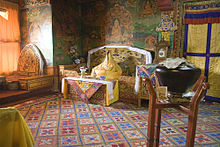
The former quarters of the Dalai Lama. The figure in the throne represents Tenzin Gyatso, the incumbent & 14th Dalai Lama.
The Potala Palace was only slightly damaged, during the Tibetan uprising against the invading Chinese forces in 1959.
Unlike most other religious buildings, the Potala was not ransacked or destroyed by the Red Guards in the 1960’s and 1970’s. This was due to the timely intervention of Chinese premier Zhou En Lai. He supposedly sent his own troops, to protect it during the Cultural Revolution.
Every year, just before the 22nd day of the 9th month of the Tibetan calendar, people will paint the walls of the palace. The actual paint is created out of milk, sugar, honey, and some herbs mixed with white lime. Centuries ago, this process would take more than a month to complete. In modern times, it is done within 10 days.
How To Get There
The Potala Palace is 70 kilometers (43.5 miles) from the Lhasa Gonggar Airport and 20 kilometers (12.4 miles) from the Lhasa Railway Station.
The Potala Palace is located 2 kilometers (1.24 miles) north of the Lhasa river, 5 kilometers (3.1 miles) south of the Sera Monastery, 3 kilometers (1.86 miles) east of Norbulingka and 2 kilometers west of the Jokhang Temple.
Location
No. 35 Gongqian Alley, Beijing Middle Road, Cheng Guan District, Lhasa 850000, China
Website http://www.potalapalace.cn/
Hours of Operation
Sunday through Saturday from 9:00 am to 2:00 pm.
The typical tour time is one hour during the peak tourist season (June to August) and two hours during the off season.
The time required to climb the more than 1000 steps, from the South Gate to the top of the Palace, is not included, as part of your tour time.
Admission And Entrance Fees
200 yuan $31.54 USD (United States Dollar) from May 01 to October 31
100 yuan $15.77 USD from November 01 to April 30
Free for children under 1.2 meters or 3.94 feet.
Discounts are available (30%) for disabled veterans and retired cadres, with proper documentation.
Visitor numbers are strictly limited. Only 2,300 can be bought per day in groups of seven. Tickets are usually sold, the day before visitation. Tickets sell quite quickly so, one must plan well ahead. Of the total, 1,600 are provided to travel agencies and only 700 for individuals.
It might well be to your advantage to book a tour of the Potala Palace, as part of a package, to avoid disappointment in visitation. Your travel agent will book a time slot, several days in advance. You will exchange that voucher for a ticket, halfway up at the entry booth.
Helpful Hints For All Travelers
- Tourists will find themselves at an altitude of 3,750 meters or 12,300 feet. Depending how long you have been in Tibet, and your own physical condition, will determine the extent of altitude sickness. Medicines are available to assist one with the problem, two weeks before or upon arrival.
- Bring identification along with your ticket, on the day of your visit.
- There is no lift or elevator up to or inside the Potala Palace. Visitors must reach the top by climbing steps for 300 feet or 100 meters. It is advisable you traverse the distance slowly, to avoid additional discomfort.
- Travelers will need to submit to a security check, to remove prohibited items. This will include cameras of any kind, as well as any food or any liquids.
- No photography or video recording is permitted inside the palace.
- The site is seen by Tibetans as being sacred. This implies visitors should arrive dressed respectfully. Hats are not allowed. You might consider bringing a coat, it can be rather cool inside the palace.
- Do a bit of research before you visit, so you will have somewhat of an idea, what the tour guides will be explaining.
- The best places to photograph the Potala Palace is Chakpori Hill, Zongjiao Lukang Park, and of course, the Potala Palace Square.

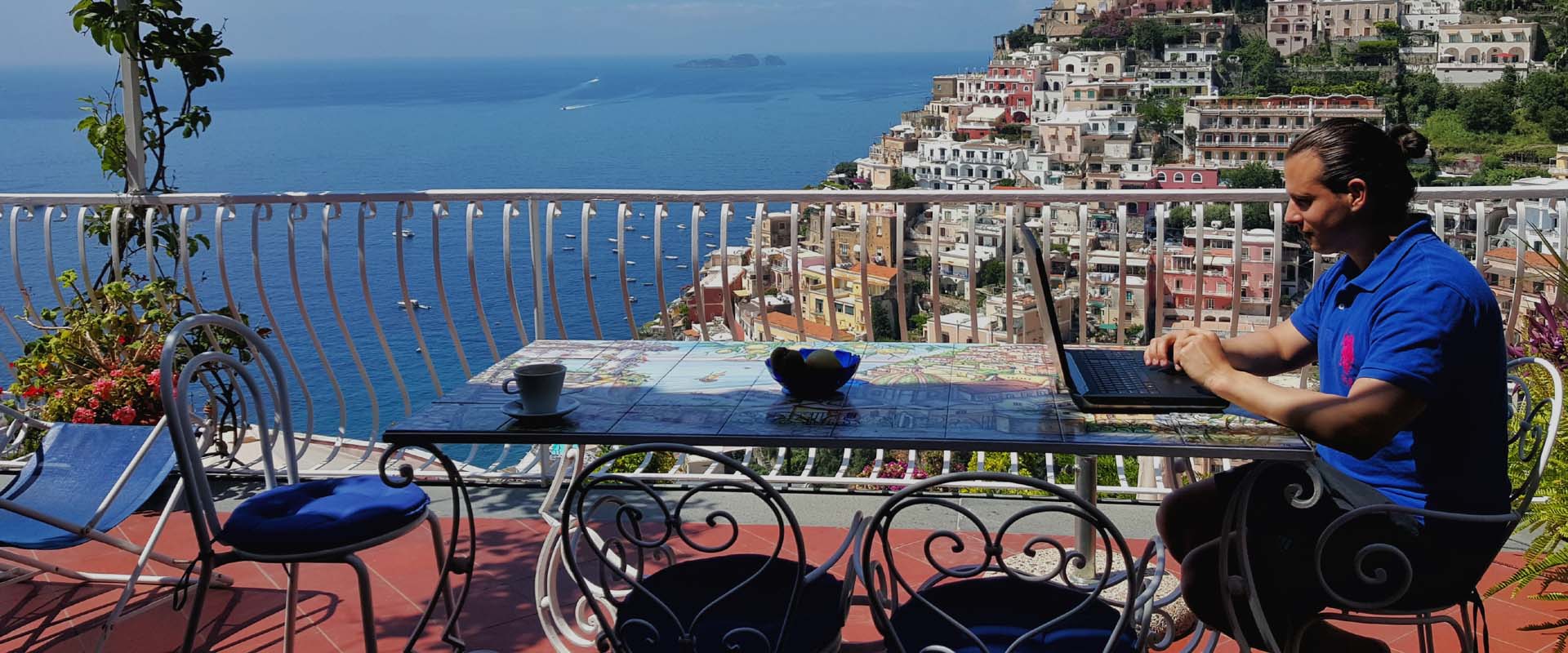
Voaavvv. Thats right. Great story. Thanks
Wow great leader still in exile, really amazed to see his place, love their culture. Thanks for sharing
Very informative article about Dalai lama. I read every book of Dalai lama, “struggle of Tibet freedom” and about his sacrifices. thanks for elaborating nicely. i’d love to explore more about him.